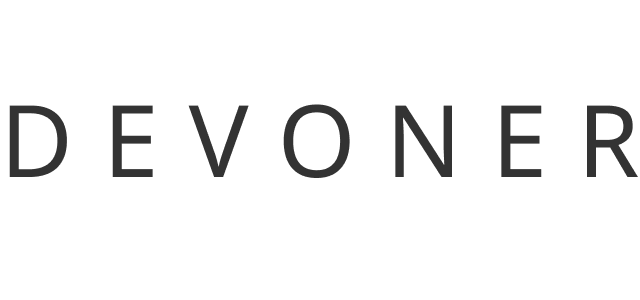A development roadmap is essential for startups looking to enhance their strategic planning abilities, regardless of the type of initiative or project. Today, these roadmaps play a pivotal role in steering the course of business and startup operations. When executed correctly, a development roadmap can streamline the ability to navigate the ever-evolving landscape of tech and innovation.
At Devoner, our seasoned team has gained top-quality insights into successfully implementing and launching complex projects using development roadmaps. We enable strong partnerships with each client, bringing a wealth of experience as a leading tech outsourcing company.
Based on our experience, we’ve compiled this strategic guide on development roadmaps to enhance your ability to streamline your software development initiatives. We’ll cover what a development roadmap is, how to build one, and how to choose the best development roadmap template to fit your needs.
Afterward, you can apply this essential knowledge to your development process, creating a strategic plan that meets your business goals.
Let’s get started!
What is a Development Roadmap?
A development roadmap is a plan that outlines product management goals, development processes, and business objectives. It provides an overview of the product’s strategic aims, the source of truth for its end users, and the development timeline. A development roadmap is a handy communication tool for the entire team.
Not only does it serve as a reference point for product owners and teams to prioritize and track the progress of product ideas, but it also outlines the product strategy. It even highlights the required features and functionality while providing a timeline for development milestones.
Significance of a Development Roadmap in Startups
The development roadmap defines goals and steps for the team. It communicates the strategy, timeline, and tasks to stakeholders and the team. It also provides oversight of projects and tasks, helping the team prioritize work. With clear aims, the development roadmap enables informed decisions, effective resource allocation, and progress tracking. Additionally, it allows team members to make fast, autonomous decisions based on a better understanding of the “big picture” provided by the development roadmap.
Various Types of Development Roadmaps
Startups have different development roadmaps for product development based on their needs and goals. These roadmaps give a clear picture of how the product development process works. There are thousands of development roadmaps out there, but here are some of the top roadmaps startups use.
1. Strategy Roadmap: A Broad View
A strategy roadmap serves as a connection between strategy and execution. It illustrates the essential outcomes that must be accomplished within a specific timeframe to realize the organization’s strategic vision.
Key Features of the Strategy Roadmap
- Goal Visualization: Clearly illustrates objectives.
- Time-Bound Plan: Outlines specific efforts within a defined timeframe.
- Team Alignment: Ensures all team members work towards shared objectives.
- Contextual Clarity: Links daily tasks to broader business or product goals.
- Impact Awareness: Helps teams understand how their work contributes to success.
2. Release Roadmap: A Detailed Timeline
The release roadmap is a detailed timeline for upcoming software releases and features. It helps the development team plan their work, prioritize tasks, and deliver the product on time.
Key Features of the Release Roadmap
- Release Date: Specifies the release date for each software release.
- Upcoming Releases: Provides an overview of upcoming software releases and their features.
- Detailed Timeline: Includes tasks, deadlines, and dependencies for each release.
- Communication Tool: Keeps stakeholders updated on product development progress.
- Alignment with Customer Needs: Ensures that features meet customer expectations through market research and feedback.
3. Marketing Roadmap: A Customer-Centric Approach
The customer-centric marketing development roadmap focuses on digital campaign timelines, target market, and communication strategy. It aligns the development team with marketing efforts to promote the product effectively.
Key Features of the Marketing Roadmap
- Timeline of Digital Campaigns: Outlines social media, content, and email marketing activities.
- Target Market: Identifies customer segments and preferences.
- Communication Strategy: Defines key messages, channels, and tactics.
- Collaboration with Sales Teams: Aligns development and sales efforts.
- Alignment with Customer Needs: Develop solutions that resonate with the target market.
4. Technology Roadmap: A Futuristic Insight
The technology roadmap provides insight into the product’s technological milestones and strategy. It helps the development team plan for the future by integrating the latest advancements.
Key Features of Technology Roadmap
- Integration of Milestones: Outlines upcoming advancements to help the team plan their work.
- Strategic Alignment: Ensures technology supports the business strategy.
- Actionable Insights: Provides informed decisions and effective task prioritization.
- Communication Tool: Updates stakeholders on progress.
- Alignment with Business Goals: Focuses on integrating technologies that support goals.
5. Portfolio Roadmap: An Overview of All Projects
The portfolio roadmap gives an overview of projects and development efforts in the startup. It aligns with business goals and strategic aims.
Key Features of Portfolio Roadmap
- Upcoming Software Releases: Timeline and features for each release.
- Ongoing Project Oversight: Clear view of tasks, milestones, and progress.
- Granular Tasks and Strategic Aims: Focus on success-contributing tasks.
- Communication Tool for Internal Stakeholders: Visibility, feedback, and support.
- Alignment with Product Success: Projects aligned with goals and customer needs.
6. Goal-Oriented Development Roadmap
Aligning the development team’s work with end users and product success, the goal-oriented development roadmap provides oversight of ongoing projects, granular tasks, and strategic aims. It offers an overview of upcoming software releases and major technological milestones, outlining the team’s overall strategy, business goals, and technology roadmap.
Key Features of the Development Roadmap
- Clear Objectives: Clearly defined and articulated goals.
- Measurable Milestones: Specific and measurable milestones.
- Time-Bound Targets: Set timelines for each goal or milestone.
- Aligned with Strategy: Integration with the broader strategic plan.
- Resource Allocation: Efficient allocation of resources to support the achievement of goals.
- Risk Mitigation Strategies: Inclusion of strategies to identify and mitigate potential risks.
Step-by-Step Guide to Building Your Development Roadmap
Now that we’ve covered the basics, let’s delve into the details of crafting your development roadmap. We’ll break down each step, providing practical ideas and guidance to ensure your roadmap is comprehensive and tailored to your project’s success.
Step 1: Assemble a Multidisciplinary Team
A multidisciplinary team is a diverse group of professionals working together. Assembling a multidisciplinary team means gathering individuals with diverse skills and expertise to manage and execute the project effectively. To ensure success, emphasize collaboration, coordination, and efficient development processes. Plus, utilize development roadmaps like software development and Gantt charts.
Steps to Assemble a Team:
- Identify Diverse Skills: Recognize the skills needed for the project.
- Select Team Members: Choose individuals with diverse skills and expertise.
- Build Collaborative Environment: Emphasize teamwork and idea sharing.
- Coordinate Communication: Establish effective communication channels among team members.
- Implement Efficient Processes: Use streamlined development processes for effective execution.
- Utilize Roadmaps: Employ tools like Gantt charts for planning and tracking progress.
- Regular Assessment: Continuously evaluate team performance and adapt strategies accordingly.
Step 2: Define the Vision for Your Product
Clearly outline the product’s vision based on concise descriptions, customer feedback, and a development timeline. The vision should cater to end users, the target market, and the development team. Involve the entire team, assign tasks, and establish release dates for new functionality. Use project management principles like Gantt charts and development roadmaps to aid this process.
Steps to Define Product Vision:
- Gain Feedback and Descriptions: Collect concise descriptions and feedback from stakeholders.
- Develop Timeline: Create a timeline with milestones and deadlines.
- Involve your Team: Involve the entire team, assigning expertise-based tasks.
- Release Plans: Establish release dates using project management tools.
- Define Vision: Clearly define the product’s vision catering to end users, the target market, and the team.
Step 3: Create the Development Roadmap
Develop a comprehensive development roadmap based on the product’s vision and strategy involving the development team. Display the features roadmap publicly, incorporating high-level and specific features while considering development time. Map out the ideas you’re committing to on your product roadmap, then break down those ideas into epics, requirements, and user stories on your delivery roadmap. Outline the next steps for the team to align with product success and business goals.
Steps to Build a Practical Roadmap:
- Define Strategy: Outline vision, goals, and initiatives and thoroughly research buying personas, product positioning, and competitive analysis.
- Review and Assess Features: Use a scoring mechanism to evaluate potential features. Identify features that bring the most value to your initiative.
- Prioritize and Determine Requirements: Break down activities supporting your strategy into manageable units.
- Organize into Phases: Group ranked features into major releases or stages. Define the duration for each phase.
- Choose Roadmap View: Decide how to illustrate the plan over a specific time frame. Highlight key features or dependencies that influence the course of your roadmap.
Step 4: Share and Refine the Roadmap
In this crucial phase, your focus shifts towards involving key stakeholders and honing in on internal and external considerations. It’s not just about presenting your development roadmap but rather about collaboration and ensuring alignment across all fronts.
Key Actions in Sharing and Refining the Roadmap:
- Engage Internal Stakeholders:
- Present the Roadmap: Conduct sessions to walk through the roadmap, explaining the rationale behind the prioritization and timeline.
- Feedback Loop: Actively solicit feedback from team members and departments involved in the project. Address concerns and incorporate valuable suggestions.
- External Validation:
- Customer Insights: Engage with end-users and key customers to validate the features and timeline. Ensure the roadmap aligns with customer expectations and market demands.
- Industry Experts: Seek insights from industry experts to ensure your roadmap aligns with current trends and technological advancements.
- Refinement and Adjustments:
- Iterative Review: Continuously review the roadmap, making adjustments based on feedback and new information.
- Flexibility: Maintain flexibility to adapt to changing circumstances, ensuring the roadmap remains relevant and achievable.
- Transparent Communication:
- Stakeholder Updates: Regularly update stakeholders on progress, changes, and any adjustments made to the roadmap.
- Documentation: Ensure all changes are documented and communicated effectively to avoid misunderstandings and maintain alignment.
Final Thoughts:
A development roadmap is more than a plan; it’s a dynamic tool guiding your project towards successful execution. By following these steps, you’ll ensure your roadmap is comprehensive, collaborative, and adaptable to the ever-changing landscape of technology and innovation.
Conclusion
A development roadmap provides clear objectives, helps identify potential risks, and keeps your project on track. By following the outlined steps, you can create a comprehensive roadmap that will guide your project to success.
At Devoner, we specialize in crafting development roadmaps tailored to your unique needs. Our experience and expertise ensure that your project is aligned with your strategic goals and is executed seamlessly. For more insights and personalized assistance, visit our Devoner website and reach out to our experts today.
Ready to streamline your project planning? Let’s start building your development roadmap today!


